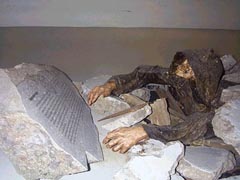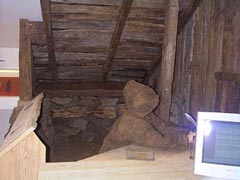|
-
Icelandic Sorcery & Witchcraft - A fascinating and unusual
Museum in Strandir -
|
|
The Early Court Cases |
|
The Early Court Cases In 1554 a priest in Eyjafj÷rur was charged with raping his sister-in-law, a minor, with the aid of grimoires found in his possession. He was outlawed from the region and sentenced to lose one arm and both ears, and to pay his father-in-law vast sums in compensation. The authorities later allowed him to keep his arm and ears, and he then became a parish priest in the Strandir region.
In
1617 the Danish authorities sent a royal order defining punishments
for witchcraft but it was probably never ratified by the general assembly
at Ůingvellir. In the following years mentions of sorcery become more
numerous in the records, especially after the trials in the seventeen-thirties
of Jˇn the Learned of Strandir, one of the most remarkable men of the
17th century. Jˇn had previously fled the Westfjords because of his
criticism of the powerful sheriff, Ari in Ígur, who had ordered the
killing of over 40 shipwrecked Basque whalers in 1615. From 1654 when three men were executed in TrÚkyllisvÝk in Strandir only one or two court cases are mentioned in the sources until the 1670s, when the witch-hunt seems to have been at its zenith. After the last execution in 1683, and especially after 1690 when a royal decree ordered that all capital offenses must be referred to the authorities in Copenhagen, the cases became fewer. In 1719 the assembly at Ůingvellir scolded a sheriff for wasting the court's time with an accusation for magic. This marks the end of the "burning-times" in Iceland.

|
last
updated
19.04.2006
<=========> web-design: sigurður atlason
© museum of icelandic sorcery & witchcraft - höfðagata 8-10
- 510 hólmavík - galdrasyning@holmavik.is - tph +354 451 3525
 The
first person burnt at the stake for practicing sorcery was a farmhand
in Eyjafj÷rur named Jˇn R÷gnvaldsson. He was accused of having raised
a ghost and sent it to do mischief on a neighbouring farm. Jˇn denied
all charges but when some pages with runic characters and signs were
found among his possessions the local sheriff promptly had him burnt.
The most likely explanation for this sudden execution is that the sheriff,
a young man who had fairly recently gotten the job after studying abroad,
decided to act swiftly and impress his superiors. Evidently he succeeded
in this because a few years later the Danish authorities demanded that
he take over the position of l÷gmaur (one of two head sheriffs in the
country) without the customary election. Twenty nine years passed until
the next fires were kindled.
The
first person burnt at the stake for practicing sorcery was a farmhand
in Eyjafj÷rur named Jˇn R÷gnvaldsson. He was accused of having raised
a ghost and sent it to do mischief on a neighbouring farm. Jˇn denied
all charges but when some pages with runic characters and signs were
found among his possessions the local sheriff promptly had him burnt.
The most likely explanation for this sudden execution is that the sheriff,
a young man who had fairly recently gotten the job after studying abroad,
decided to act swiftly and impress his superiors. Evidently he succeeded
in this because a few years later the Danish authorities demanded that
he take over the position of l÷gmaur (one of two head sheriffs in the
country) without the customary election. Twenty nine years passed until
the next fires were kindled. Jˇn did not deny having practiced healing such as found in a book of
charms and cures presented to the lawcourt (the table of contents is
copied in the court records) but staunchly denied practicing magic or
sorcery. Jˇn was outlawed from the country, but after a hearing before
the university court in Copenhagen and a second trial where the first
verdict was confirmed, he was allowed to live out his days in the east
of Iceland where he wrote a number of works, most of them for the bishop
in Skßlholt, Brynjˇlfur Sveinsson.
Jˇn did not deny having practiced healing such as found in a book of
charms and cures presented to the lawcourt (the table of contents is
copied in the court records) but staunchly denied practicing magic or
sorcery. Jˇn was outlawed from the country, but after a hearing before
the university court in Copenhagen and a second trial where the first
verdict was confirmed, he was allowed to live out his days in the east
of Iceland where he wrote a number of works, most of them for the bishop
in Skßlholt, Brynjˇlfur Sveinsson.